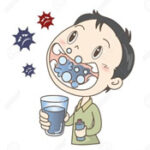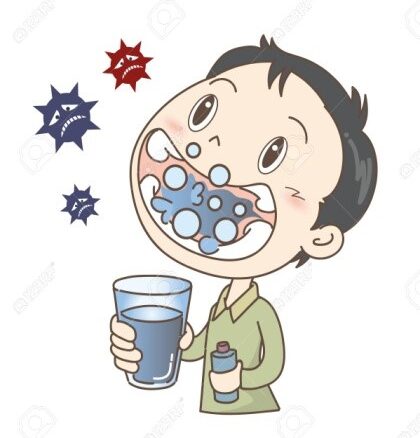
GARGLE AGAINST COVID
By: Dr. Keith Vrbicky & Summer Stanton, PA-S
As adult vaccination rates continue to rise, the totality of COVID-19 risk is diminished in adults and the new focus shifts to those whose immune systems are still developing, like children. This is especially true since children less than 12 years old are unable to be vaccinated in the United States at this time and concerns regarding post-vaccine myocarditis (inflammation of the heart) in young populations may be a risk to weigh with the benefits of the vaccine. These implications are significant as COVID-19 outcomes among younger populations are not always harmless. With cases currently surging and the seasonality of the virus, we can expect a continued surge in cases this fall – just in time for return to school.
Both new and old measures need to be taken in order to ensure a safe return to classrooms for all children. When considering the protection of our school children, a balanced approach is key. It is a complicated calculus to weigh the risks of viral infection and masking our children (as the American Academy of Pediatrics recently recommended for all students inside schools) in the long and short-term while waiting for the vaccine to be permitted in children. Additional strategies need to be considered, especially since we cannot afford to deny our children the much needed in-person education experience.
One underexplored strategy to better control admission of SARS-CoV-2 in schools may involve the use of a dilute oral antiseptic gargle or oral rinse. Similar to the two-way protection afforded by mask, treating the mouth with the safe, effective dilute antiseptic can better protect students by reducing spread and preventing infection. The idea is simple. If a child is asymptomatically infected, a before and after school oral treatment can potentially diminish the strength or number of active virus entering in infectious drops/aerosols making them less infectious. On the other hand, if a child is healthy and exposed to the virus, the treatment might provide protection against, or at least weaken, the infection. These ideas are not new, but the science of oral antiseptics and their effects on viral transmission dynamics during the last year has taken a big leap forward.
A BIT OF HISTORY: Gargles have been used for thousands of years dating back to the ancient Romans, Egyptians, and Chinese. Modern gargle science, especially with the use of alcohol-based rinses, was pulled forth with the discovery of microbes in the 19th Century. In Asia, there is a more developed culture around gargling and its health benefits. Early in the millennium, a group of Japanese doctors termed “The Great Cold Investigators” began to examine the influence of gargling on upper respiratory infections and influenza-like illnesses. What they and other investigators found is significant. A series of randomized control trails support the notion that gargling with interventions like water, green tea, and dilute povidone-iodine (PVI-an antiseptic) may indeed reduce the incidents of these illnesses. Interestingly, even the act of gargling plain tap water may reduce pieces of the virus in the nose and throat, called nasopharyngeal proteases, which are critical to viral infection. This is due to the chlorine present in tap water, which may even be of sufficient concentration to cause the viruses to become inactive.
Oral gargles do not represent a new frontier in children either, as they have been used to prevent and treat dental caries. In one landmark study conducted in Japan, middle school children who routinely gargled with dilute PVI for three months during the winter reported missing less school secondary to the common cold and influenza than others who had not gargled.
The amount of scientific information generated during the COVID-19 pandemic has been extraordinary. Gargle science has certainly benefited, as scientists and clinicians desperately look for ways to improve infection control mechanisms. Numerous reports have highlighted the efficacy of gargle active pharmaceutical ingredients like PVI, chlorhexidine, essential oils, alcohols, and hydrogen peroxide against SARS-CoV-2. The difference this time is that these studies carried over into human studies and smaller scale clinical trials, instead of just studying them in Petri dishes.
Of the all the studied active pharmaceutical ingredients, perhaps the best data has been generated with dilute PVI (Betadyne 0.5% Gargle Solution). This is a broad spectrum antimicrobial with years of data supporting its ability to decontaminate human tissues and kill contagions capable of pandemic spread. It is safe, makes to World Health Organization list of essential medicines, and has not been implicated in antimicrobial resistance. Its use is not known to alter the supportive microbiome of the gut. Additionally, independent clinical trials in the setting of active COVID-19 have shows that administration of dilute PVI decreases the virus’s RNA , those who test positive to viral antibodies, and decreases active virus in the mouth fluid/ respiratory droplets. It has also been shown to speed viral clearance protect against infection.
From the outset of this SARS-CoV-2 pandemic, the idea of oral rinses with safe and effective antiseptics was well founded, but has lacked supportive data. Now, given the existence of these expanding reports the evidence is supportive that use of dilute oral antiseptics may be a safe way to reduce viral transmission. The relatively small scale of gargle based clinical trials leaves them vulnerable to the criticisms of being poorly performed and underpowered. While large scale randomized controlled trials are certainly lacking, there is still much to be gleaned from other types and levels of evidence, especially when backed by millennia of favorable experience and implemented for clinical necessity during a pandemic. The low cost, safety, and preventive practice of gargling or oral rinsing is also consistent with the precautionary principle and the oath of Hippocrates-“do no harm or injustice”-making it perhaps an ideal intervention for our vulnerable children when they return to school, especially in combination with other public health measures.
Perhaps if all adults and school-age children use a proactive approach of gargling every morning and every evening, along with the possible use of intranasal prophylactic sprays, we may see a significant decrease in the incidence and severity of not only SARS-CoV-2 infections, but other serious infectious respiratory illnesses such as influenza, respiratory syncitial virus (RSV) and even the common cold.
Reference Article By: Jesse Pelletier, MD, and Terrence P. O’Brien, MD/ Med Page July 2021


